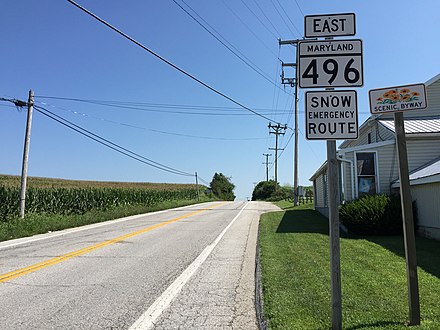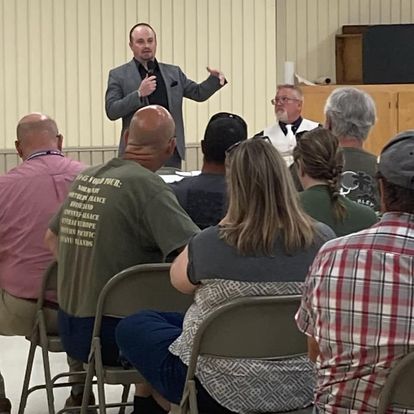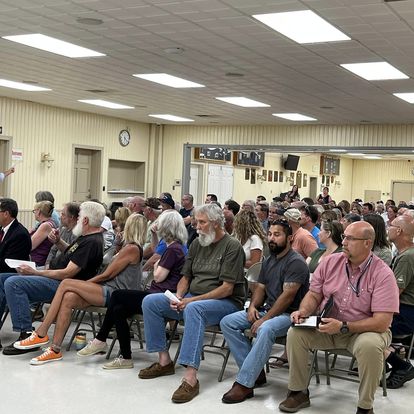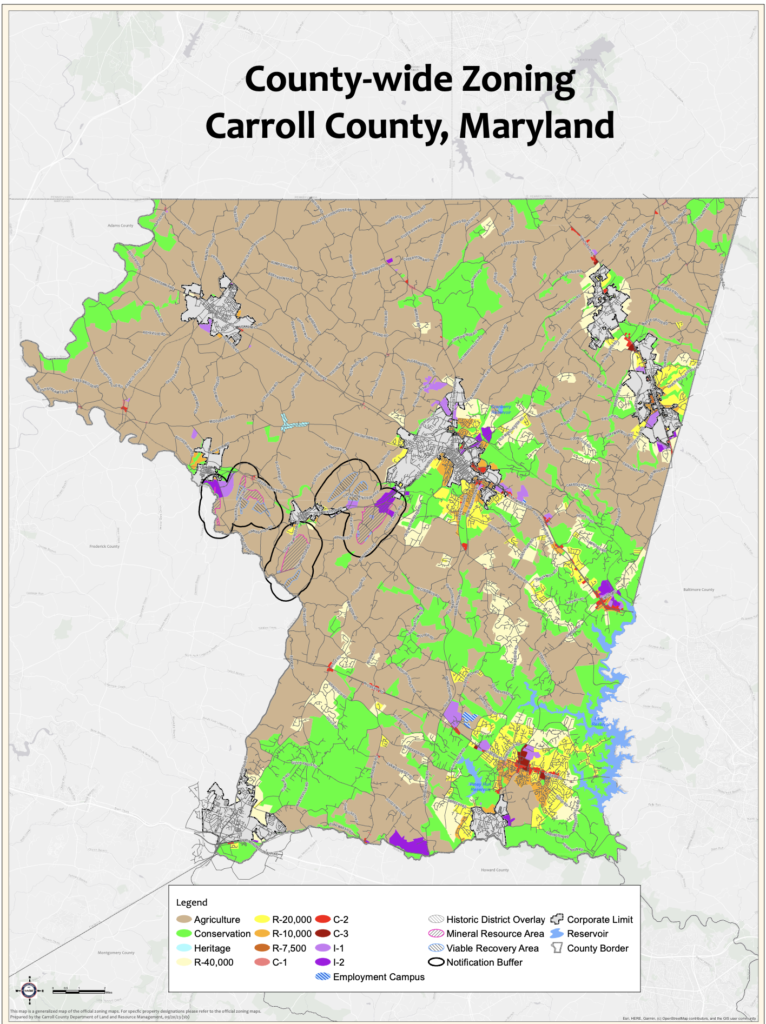Chaos in Bachmans Valley – Why it Matters to all Carroll Countians
The Latest Battle in the War Between Zoning and Property Rights

In what is starting to resemble a scene from the movie Groundhog Day, homeowners outside of Manchester are finding themselves embroiled in the latest showdown between conflicting county priorities and vague zoning versus the rights of property owners located in Carroll County’s Agricultural District.
From acres of industrial solar panels, golf driving ranges that hold concerts and country nursing homes that become drug rehabilitation facilities, there seems to be no way for citizens to predict what will be allowed next among the quiet farms and residences. This disturbing trend is causing many to ask, “do we as property owners have the right to expect certain conditions regarding the noise, scenic vistas, traffic, etc when buying property in Carroll County’s nationally recognized Agricultural District”?
At first glance, according to chapters 158 and 159 of the county code it would seem that they do have that right. Chapter 159 clearly states “The purpose of this chapter is to recognize the value of the county’s heritage, agricultural and resource-based economy, rural and scenic characteristics, cultural resources, and natural and environmental resources…”
However, when reviewing the over 70 principle/conditional uses and the exceptions/ modifications to the bulk requirements especially in regards to height, almost anything can be designed to fit in the Ag district. Even a massive church retreat with a gold dome adorning a 10,000 sq ft building, towering 60 feet over the valley. One would be hard pressed to understand how a structure of this size “maintains the character of the surrounding countryside”.
**Just the latest controversy**
But the latest Ag district controversy has residents asking just that question. A once idyllic part of northern Carroll County, Bachmans Valley used to be home to serene farmland, winding roads and quiet private residences. However, the area is now grappling with the influx of tourist buses, traffic congestion, blaring noise, and a string of property-related issues related to a church situated on 25 acres at 2239 Bachmans Valley Road.

The 25 acre property was purchased by the Ethiopian Orthodox Tewahedo Church (EOTC) in 2017. While religious establishments are permitted in the Ag district, there doesn’t appear to be adequate oversight regarding bulk requirements and noise ordinances. The absence of this oversight has led to the relationship between the EOTC and their neighbors becoming contentious, due in large part to the weekend worship services attended by up to 500 parishioners and larger feast day festivals, held several times a year. The festivals have drawn close to a thousand out-of-town participants, arriving in both cars and tourist buses. During the last festival, the Carroll County Sheriff’s Department was hired to direct traffic.
In January 2021, EOTC submitted a concept plan to Carroll County’s Department of Planning and Zoning with intentions to construct a 10,000 sq ft megachurch adorned with a golden dome, an estimated 6,600 sq ft holy-water immersion building and a billboard-sized free standing sign at the driveway entrance on Bachmans Valley Road.

At a Planning Commission meeting this past summer, neighbors were holding back tears and overcome with emotion as they described issues ranging from near miss traffic accidents resulting in the death of farm animals, strangers wandering from events onto adjacent properties, unsolicited tree removal from adjacent properties, traffic congestion from bus and car traffic and loud music/chanting that can be heard for miles, radiating throughout the valley starting before 7am and continuing throughout the day.
Neighbors also questioned the long term effects these events and the potential large/intrusive structures would have on the community. Specifically on groundwater needed for existing well and septic systems and destruction of scenic vistas. Representatives from EOTC tried to calm these worries by stating bottled water and portable restrooms would be used instead of permanent bathrooms inside the new 10,000 sq ft facility.
And while the church expansion’s potential impact on travel in the area is clear due to the amount of attendees, the Maryland State Highway Administration has approved the concept plan without conducting a traffic study. A troubling fact that has raised many eyebrows given the obvious need to widen the road and install turn lanes in order to accommodate the large, sudden influx of vehicles.
In July, State Delegates Chris Tomlinson and Eric Bouchat, alongside District 2 County Commissioner Ken Kiler, convened a town hall to hear the concerns of residents from Ebbvale, Melrose, and Bachmans Valley. Delegate Tomlinson had this to say when Informed Carroll reached out for comment. “Commissioner Kenny Kiler and I have been hearing about the problems the Church has created for over a year. However, after our town hall meeting was held, with over 125 members of the Melrose, Bachmans Valley, and Ebbale communities in attendance, I have major concerns with the behavior of this organization and question how they will be able to get the proper authorization from the County and State to expand like they wish to. I have heard and seen firsthand how this Church treats its neighbors. Trespassing, property damage, harassment, and that is only the beginning. I have asked this question over and over again – if this is how they treat their neighbors when they are going through the Planning & Zoning process, how are they going to behave once they get what they want?”


To be fair, the argument could be made that the true culprit behind this and the other recent issues is the need to reevaluate county priorities and vague zoning codes that leave both residential AND business property owners guessing.
**Is Carroll County nearing a tipping point?**
Forty years ago the board of county commissioners officially made agriculture and the preservation of ag land a pillar of Carroll County’s culture. Since then the county has not only become first in the state for land preserved and second in the country for the number of acres preserved through easement purchases, it has also dedicated over 240 million tax dollars to Ag land preservation.
However, are these recurring conflicts a sign that it might be time for our elected officials to revisit that decision? District 4 Commissioner Mike Guerin has tried to address the need for zoning clarity by spearheading two separate work sessions where he asked county staff to make the zoning definitions in the Ag district clearer. And while his colleague, District 1 Commissioner Joe Vigliotti also voiced support for more clarity, each of the two work sessions ended without any tangible outcomes.
During the first work session on June 1st former director of planning, Lynda Eisenberg went as far as to say that staff had actually made development in the Ag district MORE restrictive, which recent events obviously prove otherwise. And the work session on June 29th consisted of county staff making sure Carroll’s zoning definitions were consistent with federal and state zoning definitions. Neither of which did anything to address the real problem and certainly didn’t provide the commissioners with tools and solutions to calm their constituents.
Perhaps the issue isn’t clarity then, but instead the need to address an obvious cultural shift within the county. Is it time for our elected officials to acknowledge that the rural and agricultural Carroll County of 1980 doesn’t exist anymore? And if so, they have a duty to direct staff to rework the county zoning codes to set clear expectations for homeowners when buying property and also to protect the potential business owners from partaking in a long and arduous approval process only to have the rug pulled out from under them due to community outcry.
One only has to look to this past budget session to see the obvious signs of this shift. Due to massive residential development, everything from school construction, a professional Fire/EMS department, expansions for both the sheriff and state’s attorney and extensive road projects are on the docket for the coming years with no clear way as to how the county is going to pay for them.
Currently, the tax revenue burden in Carroll County largely falls to residential property owners in the form of property taxes. Overall property taxes make up almost half of the entire general fund revenue sources with income taxes coming in second. Of that, residential property taxes make up roughly 82%, while business and agricultural property taxes make up about 12%, and 6% respectively. In terms of land use, over 80% of county controlled land is located in the Agricultural and Conservation districts. Only 2.9% is zoned Commercial/Industrial compared to a county like Harford which has almost 6% of land dedicated to a business district and more developed counties seeing up to 20% of their property taxes coming from commercial/industrial.

These two factors alone paint a convincing picture that preserving Carroll County’s treasured Ag district through very restrictive zoning codes and removing the exceptions to the bulk requirements would go a long way to protecting the residents and farms located there. And turning the county’s land management focus from Agriculture to Commercial would benefit and maybe draw potential businesses. Bringing with them their business property taxes that are going to be vital to the county’s mission to raise revenue in order to address its rapidly approaching inadequate public infrastructure.
It will be interesting to see if the BOCC has the stomach to pivot the county’s focus from Agriculture to Commercial, maybe even abandoning the elusive goal of preserving 100,000 acres set back in 1980. And of course, if we are to believe a commissioner left over from the last board, the only solution to every issue that ails the county is to raise taxes and fees on the already overburdened residential tax payers. But we can pray that at the end of the day, our four new commissioners will fight to overturn every stone and look for all outside the box ideas before giving in to that possibility.




